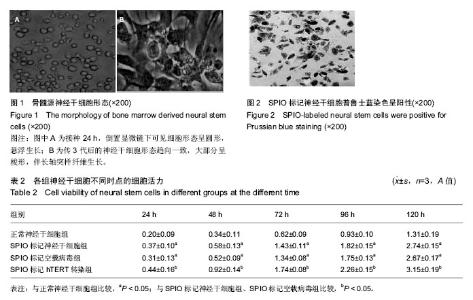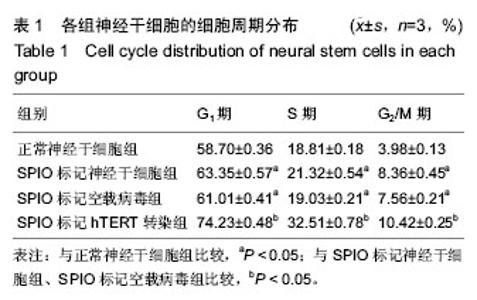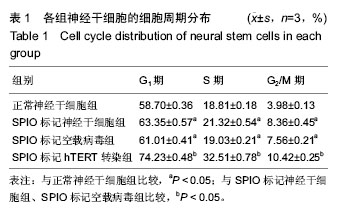| [1] Kanaykina N, Abelson K, King D, et al. In vitro and in vivo effects on neural crest stem cell differentiation by conditional activation of Runx1 short isoform and its effect on neuropathic pain behavior. Ups J Med Sci. 2010;115(1):56-64.
[2] 王娜,刘砚星,连易水,等.神经干细胞研究进展[J].生物学杂志,2009,26(1):55-58.
[3] Chaudhry GR, Fecek C, Lai MM, et al. Fate of embryonic stem cell derivatives implanted into the vitreous of a slow retinal degenerative mouse model. Stem Cells Dev. 2009;18(2):247-258.
[4] 钱晓丹,罗春霞,朱东亚.神经干细胞移植研究进展[J].中国细胞生物学学报,2012,34(3): 212-217.
[5] Ormerod BK, Palmer TD, Caldwell MA. Neurodegeneration and cell replacement. Philos Trans R Soc Lond B Biol Sci. 2008;363(1489):153-170.
[6] 李祥,朱文珍,魏黎.氧化铁纳米粒子神经干细胞标记技术的比较研究[J].中国医学影像学杂志,2014,22(1):7-11.
[7] Ramaswamy S, Schornack PA, Smelko AG, et al. Superparamagnetic iron oxide (SPIO) labeling efficiency and subsequent MRI tracking of native cell populations pertinent to pulmonary heart valve tissue engineering studies. NMR Biomed. 2012;25(3):410-417.
[8] Cromer Berman SM, Kshitiz, Wang CJ, et al. Cell motility of neural stem cells is reduced after SPIO-labeling, which is mitigated after exocytosis. Magn Reson Med. 2013;69(1):255-262.
[9] 李祥,漆剑频,朱文珍,等.氧化铁标记神经干细胞对大鼠放射性脑损伤的磁共振成像研究[J].中华细胞与干细胞杂志, 2012,2(1):23-26.
[10] 张瑞平,刘强,李晶,等.超顺磁性氧化铁标记鼠骨髓间充质干细胞的体外MR成像研究[J].中国医学影像学杂志, 2009,17(4): 257-261.
[11] 程峰,郝怀勇,田和平,等.体外诱导骨髓间充质干细胞向神经细胞分化及凋亡的研究[J].南京医科大学学报,2010, 30(1):54-58.
[12] 毕涌,洪娟,李力群,等.重组质粒pcDNA3-β-NGF的构建及其转染小鼠骨髓间充质干细胞生物学活性的研究[J].中国病理生理杂志,2013,29(11): 2082-2087.
[13] 杨智勇,宋晓斌,邓兴力,等.SPIO、GFP双标BDNF基因修饰中脑神经干细胞的研究[J].中国微侵袭神经外科杂志, 2010,15(7):323-326.
[14] 包金风,王虹,吴凡,等.成年小鼠神经干细胞体外培养、鉴定及分化[J].神经解剖学杂志,2011, 27(2):191-197.
[15] 胡海雷,实时荧光定量RT-PCR检测胃癌患者外周血hTERT mRNA表达水平[J].放射免疫学杂志,2011, 24(2): 182-185.
[16] 杨明峰,刘安定,郑专,等.体外siRNA抑制乳腺癌细胞株端粒逆转录酶基因的表达[J].第四军医大学报,2008,29(19): 1761-1764.
[17] Kim TS, Misumi S, Jung CG, et al. Increase in dopaminergic neurons from mouse embryonic stem cell-derived neural progenitor/stem cells is mediated by hypoxia inducible factor-1alpha. J Neurosci Res. 2008;86(11):2353-2362.
[18] Hayashi O, Katsube Y, Hirose M, et al. Comparison of osteogenic ability of rat mesenchymal stem cells from bone marrow, periosteum, and adipose tissue. Calcif Tissue Int. 2008;82(3):238-247.
[19] Himes BT, Neuhuber B, Coleman C, et al. Recovery of function following grafting of human bone marrow-derived stromal cells into the injured spinal cord. Neurorehabil Neural Repair. 2006;20(2):278-296.
[20] Medrano S, Burns-Cusato M, Atienza MB, et al. Regenerative capacity of neural precursors in the adult mammalian brain is under the control of p53. Neurobiol Aging. 2009;30(3):483-497.
[21] Nisbet DR, Crompton KE, Horne MK, et al. Neural tissue engineering of the CNS using hydrogels. J Biomed Mater Res B Appl Biomater. 2008;87(1): 251-263.
[22] Ryu JK, Cho T, Wang YT, et al. Neural progenitor cells attenuate inflammatory reactivity and neuronal loss in an animal model of inflamed AD brain. J Neuroinflammation. 2009;6:39.
[23] Sun Y, Feng Y, Zhang C. The effect of bone marrow mononuclear cells on vascularization and bone regeneration in steroid-induced osteonecrosis of the femoral head. Joint Bone Spine. 2009;76(6):685-690.
[24] Ross JJ, Verfaillie CM. Evaluation of neural plasticity in adult stem cells. Philos Trans R Soc Lond B Biol Sci. 2008;363(1489):199-205.
[25] Maurer J, Fuchs S, Jäger R, et al. Establishment and controlled differentiation of neural crest stem cell lines using conditional transgenesis. Differentiation. 2007; 75(7):580-591.
[26] Ilancheran S, Michalska A, Peh G, et al. Stem cells derived from human fetal membranes display multilineage differentiation potential. Biol Reprod. 2007;77(3):577-588.
[27] Willenbrock S, Knippenberg S, Meier M, et al. In vivo MRI of intraspinally injected SPIO-labelled human CD34+ cells in a transgenic mouse model of ALS. In Vivo. 2012;26(1):31-38.
[28] de Chickera S, Willert C, Mallet C, et al. Cellular MRI as a suitable, sensitive non-invasive modality for correlating in vivo migratory efficiencies of different dendritic cell populations with subsequent immunological outcomes. Int Immunol. 2012;24(1): 29-41. |





